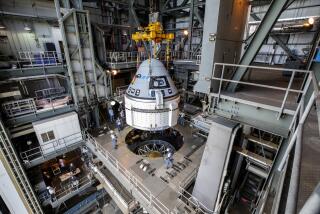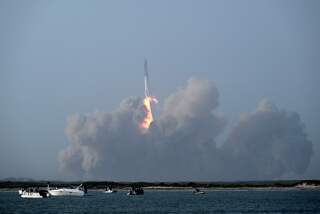NASA’s Shuttle Problems Lead to Rocketdyne : Aerospace: Space shuttle launch delays have been traced to problems in the Rockwell unit’s engines. The Canoga Park unit says it is improving procedures and training.
- Share via
The weather was perfect at Cape Canaveral on Aug. 12 when the space shuttle Discovery’s engine roared to life, only to have the launch halted by a computer just three seconds from liftoff. NASA traced the shutdown to a faulty fuel sensor in the engine, and again the finger was pointed at Rocketdyne.
The Canoga Park-based unit of Rockwell International makes the shuttles’ main engines. This year those engines have caused two last-second aborted launches, and at least two more launch delays involving the Columbia and Endeavor space shuttles, much to NASA’s chagrin.
“It’s embarrassing to NASA, and they’re annoyed,” said Seymour Himmel, a retired NASA engineer who is an aerospace consultant in Cleveland.
NASA Administrator Dan Goldin said in an interview, “The fact of the matter is, we did have quality problems at Rocketdyne.”
Rocketdyne’s lapses have been both small and big, experts said, some potentially catastrophic to a shuttle launch, such as a missing part in a turbine disk that could cause a shuttle engine to lose thrust. Each shuttle has three main engines, which along with two booster rockets propel the spacecraft into orbit.
As a result, NASA this spring launched an extraordinary inspection of the shuttle engines and Rocketdyne’s work. In May a dozen NASA engineers and quality experts arrived for a monthlong review at Rocketdyne’s facility in Canoga Park and found two key areas of deficiency: There were discrepancies between NASA’s specifications and designs and Rocketdyne’s blueprints, and in some cases Rocketdyne’s technicians were not following the procedures in their own manuals.
“We recommended to Rocketdyne that they make some fundamental changes,” said Wayne Littles, deputy director of the Marshall Space Flight Center in Huntsville, Ala., which manages the shuttle engines and has been leading the Rocketdyne investigation. Littles said his team will revisit Rocketdyne’s Canoga Park plant next month, to make sure that the company has “set up procedures and policies that will prevent this sort of thing from happening in the future.”
Goldin ordered the inspection of Rocketdyne after the missing piece in a turbine assembly was discovered in February, as well as a mislabeled engine part and another piece with the wrong dimensions on an engine pump. That forced the space agency to postpone the Columbia shuttle launch by a month until late March. Then on March 22, the Columbia flight was halted three seconds before liftoff, because a valve in one of the shuttle’s main engines picked up a speck of debris and failed to close.
The aborted launches were only the third and fourth times in the shuttles’ 12-year history that engines were shut down on the launching pad--a dangerous procedure because of massive amounts of burning fuel. The launch of a third space shuttle, the Endeavor, also was postponed in June because, NASA said, Rocketdyne failed to correctly document one of the parts in the engine pump.
“In some people’s eyes, Rocketdyne’s credibility has been shaken,” said Norman Parmet, chairman of the Aerospace Safety Advisory Panel, a group formed by Congress in 1967 to provide an independent critique of NASA. In January the panel urged NASA to make several other long-term safety modifications to Rocketdyne’s shuttle engines to reduce the chances of catastrophic failure.
Despite Rocketdyne’s problems, NASA analysts say it’s unlikely that Rocketdyne will lose the shuttle contract because few companies are capable of making engines as powerful as the 12-million horsepower motors used on the shuttle. Plus, Rocketdyne has been manufacturing and servicing shuttle engines for two decades, and until this year, it has had few problems.
But in an age of shrinking defense budgets and critics clamoring to cut expensive space programs, neither NASA nor Rocketdyne can afford to make such mistakes.
This year’s shuttle launch errors are particularly glaring because last year, seven of the eight shuttle flights were launched on schedule, with the eighth delayed by just a day. So far this year NASA has launched just four shuttles, despite boarding astronauts and beginning the launch countdown 11 times. Some delays were caused by bad weather and problems unrelated to Rocketdyne, such as a flaw in the booster rocket made by Thiokol Corp.
*
For NASA, each aborted launch costs between $600,000 and $1 million, adding to the program’s $5 billion in costs. The agency’s mission includes lofting and repairing vital satellites and conducting scientific experiments.
Sam Iacobellis, who is deputy chairman of Rockwell International, Rocketdyne’s Seal Beach-based parent company, oversees the shuttle program. Iacobellis could not pinpoint why Rocketdyne’s shuttle engines, after two decades of near-flawless performance, were causing repeated problems this year.
Iacobellis said Rocketdyne conducted its own investigation before NASA’s team arrived this spring and for the first time shut down production for several weeks as Rocketdyne’s workers went through every detail of production. “We found over 99.9% of the procedures were correct and consistent,” he said.
But Iacobellis also admitted that Rocketdyne had made some mistakes, and said the company’s inspection reached some of the same findings as NASA’s. So Rocketdyne is spelling out its work procedures in detail and enhancing training, he said. The company also disciplined about 10 employees, but Iacobellis declined to elaborate.
“We’ve seen some significant improvements” with the steps Rocketdyne has taken, said NASA’s Goldin. But he added: “There’s a lot more room for improvement.”
For Rocketdyne, the engine contract is critically important and brings in about $340 million a year--one-third of Rocketdyne’s annual revenue. And the jobs of about one-third of Rocketdyne’s 6,000 employees in Canoga Park are tied to the shuttle engine. The rest of Rocketdyne’s revenue comes mainly from building engines for NASA’s proposed space station and for the Atlas and Delta rockets that launch commercial and military payloads into space.
Rocketdyne has had other troubles this year unrelated to the shuttle. In March the launch of a $137-million satellite did not reach a high enough orbit, because a Rocketdyne-built Atlas rocket malfunctioned due to a loose screw inside the engine.
General Dynamics, the satellite general contractor, said its investigation showed that the root cause of the launch failure was that Rocketdyne performed some work without detailed instructions, also a key finding in NASA’s review.
In Rocketdyne’s defense, analysts say some of this year’s problems with the shuttle engine were neither serious nor entirely Rocketdyne’s fault. A shuttle engine has about 50,000 parts, and Rocketdyne uses about 30,000 pages of shuttle assembly instructions.
“The thing is that it’s a complicated machine, and you can expect problems from time to time,” said consultant Himmel. “I don’t think there are any contractors who are innocent of having had problems like this.”
Earlier this month in the latest attempt to launch Discovery, a faulty sensor gave an inaccurate reading of fuel flow. Although there was no problem with fuel flow and three other sensors gave an accurate reading, computers were programmed to shut down the flight if any of the sensors malfunction--which some say is a reflection of overly conservative procedures. The launch of Discovery is now scheduled for Sept. 10, and NASA has changed the program so that the vehicle will take off even if one of the fuel-flow sensors gives an improper reading.
Littles, of NASA’s Marshall Space Flight Center, agreed that if the only problem with the Discovery launch in August was the faulty sensor, it may well have been a perfectly normal flight. Still, Littles said that even a minor flaw “increases the probability of a problem during flight.”
Littles said the missing turbine assembly piece discovered on the Columbia shuttle in February was much more serious. That metal piece, about half an inch in size, connects blades in the turbine disk. If that piece is missing, Littles said, “you could get a catastrophic problem with a blade that breaks,” which could cause engine failure.
But the bigger concern for NASA, he said, was a system that allowed such a problem to occur.
“You had an error in not installing the part, then an error with the inspector whose job it was to inspect that,” Littles said. “That you have a system that would allow those kinds of problems, not just once but more than once, is the fundamental cause for concern.”
More to Read
Inside the business of entertainment
The Wide Shot brings you news, analysis and insights on everything from streaming wars to production — and what it all means for the future.
You may occasionally receive promotional content from the Los Angeles Times.











